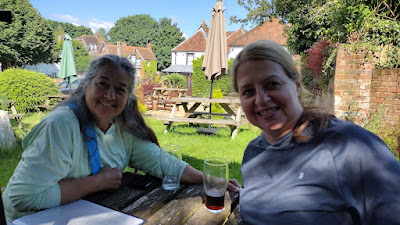Ridgeway Tip VI: The Longest Day (I thought)
We left the fanciest pub we'd stayed at so far, the Greyhound Inn, and toiled our way up that mile and a half track that got pretty steep before it hit the Ridgeway. (Because, of course, the Ridgeway is up, and most other things are not!) This was going to be a very long day of over ten miles, so we were a bit uncertain. But the track itself was quite easy; almost always broad and fairly level. At first it was chalk, and then chalk that had been evened out with rubble. Fairly near a farm, I spotted a piece of blue-glazed pottery and prized it out of the road to keep. It's scratched up but still pretty!
 |
| From the village, a view of our road up to the Ridgeway, which is marked by the trees up top |
We passed through a lovely winding bit shaded by huge trees, and then spent a lot of time on grassy track. Even the guide book says "continue walking on this seemingly never-ending broad, grassy track"! We crossed a road into a little car park where, we discovered, people like to drive up to walk their dogs. Here there were a couple of logs to block cars from the track so we sat and took a break, and discovered that there were red kites hunting over the fields. They're beautiful, graceful birds, and would often hover in mid-air, keeping completely still in some breeze, checking out the field below for anything going. Then they'd move over sideways a little way and do it again, covering a large amount of ground without moving much -- until they decide to swoop around again.
 |
| Teeny snail I spotted while we rested |
We found out that red kites were once common, but for a few hundred years there after 1600, it became the thing to kill any birds of prey no matter how helpful they actually were. By the beginning of the 20th century, red kites were nearly extinct in Britain, and were declining in Europe as well. A dedicated conservation and re-introduction program has brought them back and we saw many -- probably every day for the rest of the walk.
 |
| My futile attempt to photograph a swooping kite |
We got going and met many dog=walkers, and got along until we met Baron Wantage's monument, a tower with a Celtic cross on top dedicated to the memory of a Victorian baron. It has steps, so is a good place to rest.
We toiled a long way, hoping to find a good spot to eat lunch, but it's not easy. We pinned our hopes on Scutchcambe Knob, which is just a little hill or barrow covered in growth, but which has a nice copse of beech trees alongside. We found a very low, very narrow log and used that for our seat. Maybe 100 feet past the copse, there is a proper, comfortable bench....

After this, you're still high up, but can hear the A34 motorway from quite far away, since there's nothing to block it. You can also see a business/industrial area way down below -- just massive, with lots of buildings. I found out a few weeks later that it is in fact part of Britain's military technology program and was established in World War II as a place for 'boffins' to work. The equivalent of Los Alamos, I suppose. (Is The Leaky Establishment set there?).
 |
| This memorial to a young soldier isn't very prominent |
 |
| Giant concrete Legos probably had a job at some point... |
 |
| Cooling off afterwards |











Comments
Post a Comment
I'd love to know what you think, so please comment!